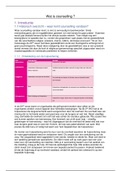Chapter 1: Introduction to Business Process Management....................................................................2
Chapter 2: Process Identification............................................................................................................9
Chapter 3: Essential Process Modeling.................................................................................................18
Chapter 5: Process Discovery...............................................................................................................28
Chapter 6: Qualitative Process Analysis................................................................................................41
Chapter 7: Quantitative Process Analysis.............................................................................................52
Chapter 8: Process Redesign................................................................................................................65
Chapter 11: Process Monitoring...........................................................................................................80
Chapter 12: BPM as an Enterprise Capability.......................................................................................96
1
,Chapter 1: Introduction to Business Process Management
Business process management the art of science of overseeing how work is performed in an
organization to ensure consistent outcomes and to take advantage of improvement opportunities.
It about managing the entire change of events, activities and decisions that ultimately add value to
the organization and its customers.
Processes chains of events, activities, and decisions
1.1. Processes everywhere
Typical examples of processes that can be found in most organizations include:
Order-to-cash this is a type of process performed by a vendor, which starts when a customers
submits an order to purchase a product or a service and ends when the product or service in
question has ben delivered to the customer and the customer has made the corresponding
payments. It encompasses activities related to purchase order verification, shipment (for physical
products), delivery, invoicing, payment receipt, acknowledgement
Quote-to-order it precedes an order-to-cash process. It start from the point when a supplier
receives a Request for Quote (RFQ) from a customer and ends when the customer in question
places a purchase order based on the received quote. From that point on order-to-cash.
Combination of these two Quote-to-cash
Procure-to-pay starts when someone in an organization determines what a given product or
service needs to be purchased. It ends when the product or service has been delivered and paid
for. Activities like: obtaining quotes, approving the purchase, selectin a supplier, issuing a
purchase order, receiving the goods and paying the invoice. Can be seen as the counterpart of
the quote-to-cash process in the context of business-to-business interactions. Fore very procure-
to-pay process there is corresponding quote-to-cash process on the supplier side.
Issue-to-resolution start when a customer raises a problem or issue (like complaint related to
a defect or encountered when consuming a service). The process continues until the customer,
the supplier, or both of them agree that the issue has been resolved. A variant of this process
insurance companies, where the have to deal with claims claim-to-resolution.
Application-to-approval starts when someone applies for a benefit or privilege and ends
when the benefit or privilege in question is either grander or denied. government agencies,
citizens apply for building permits, another process that falls into this category is the admission
process in a university, process for approval of vacation or special leave request in a company.
The way process are designed and performed affects both
Quality of service that customers perceive
Efficiency with which services are delivered
1.2. Ingredients of a Business Process
Events things that happen automatically and have no duration.
Activities takes time. refer to both fine-grained or coarse-grained units of work
Task when an activity is simple and can be seen as one single unit of work. fine-grained unit of
work performed by a single process participant.
Decision points points in time when a decision is made that affects the way the process is
executed.
Processes also involve:
Actors human actors, organizations, software system (action on behalf of human actors or
organizations)
o Internal operate inside the organization process participants
o External operate outside the organization where the process is executed.
2
, Physical objects equipment, materials, products, paper documents
Informational objects electronic document, electronic records.
Execution of a process lead to one or several outcomes. should deliver value to the customers.
Negative (no value) and
positive (delivers value to the customer) outcomes.
Customer the one that consumes the output
Can be that there a multiple customers in the process.
1. Who are the actors in this process?
2. Which actors can be considered as customers in this process?
3. What value does the process deliver to its customers?
4. What are the possible outcomes of this process>
Business process a collection of inter-related events, activities, and decision points that involve a
number of actors and objects, which collectively lead to an outcome that is of value to at least one
customer.
Figure 1.1
BPM a body of methods, techniques, and tools to identify, discover, analyze, redesign, execute,
and monitor business processed in order to optimize their performance.
business process are the focal point of BPM. BPM involved different phases and activities in the
lifecycle of business process.
Related desciplines other desciplines beside BPM deald with business processes in different ways
Related disciplines (key relations and difference page 7).
Total quality management
Operations management
Lean
Six Sigma
We can say that BPM inherist from the continuous improvement philosophy of TQM, embraces the
principles and techniques of operations management, Lean and Six Sigma, and combines them with
the capabilities offered by modern information technology, in order to optimally align business
process with the performance objectives of an organization
1.3. Origins and history of BPM
1.3.1. The functional organization
Figure 1.2. provides an overview of some historical developments relevant to BPM.
Prehistoric times – pure generalist – entire process for all products
Ancient times – intermediate level of specialism – entire process for a single product
Middle ages – craftsman
Industrial times – pure specialist – single part of a process for single product.
division of labor (while Smith)
scientific management (Frederick W. Taylor) division of labour an work analysis.
class of manages one of the side effects of Scientific management
functional organization emerged from the mindset of the second industrial revolution.
3
, 1.3.2. The Birth of Process Thinking
Business Process Rethinking – Hammer and Champy – the fundamental rethinking and radical
redesign of business process to achieve dramatic improvements in critical, contemporary measures
of performance, such as cost, quality, service and speed.
Figure 1.3. purchasing with ford.
Redesign in figure 1.4.
Article Look at the entire, end-to-end process when trying to improve the operations of their
business, instead of looking at one particular task or business function. also say that IT has an
important role to come up with redesign of existing business processes.
1.3.3. The rise and fall of BPR
Business process redesign or business process reengineering
1. Concept misuse
2. Over-radicalism
3. Supporting immaturity
Two key even event revived some of the ideas behind BPR and laid foundation for the emergence of
BPM:
1. Empirical studies appeared, showing that organizational that were process-oriented factually did
better than non-process-oriented organizations
2. Technological in nature. e.g ERP (enterprise resource planning) en WfMSs (workflow
management systems)
BPMS (business process management systems).
Many others: customer relationship management (CRM), document management systems (DMSs)
Umbrella terms Process-Aware Information Systems (PAIS)
BPM is a revival of BPR, as indeed BPM adopts the process-centred view on organizations. Some
caution is due, though, when BPR and BPM are equated. The relation is much better understood on
the basis of figure 1.5.
Process owner manger that is responsible for a business process
Figure show that the process managers is concerned with planning and organization the process on
the one hand and monitoring the process on the other.
Differences in scope between BPR and BPM
Both take the business process as starting point. BPR is concerned with planning and organizing the
process. BPM provides concepts, methods, techniques, and tools that cover all aspects of managing a
process – plan, organize, monitor – as well as actual execution.
BPR should be seen as a subset of techniques that can be used in the context of BPM.
BPM lifecycle
1.4. The BPM lifecycle
The team will not start from scratch.
How much has the organization be done with process thinking.
4











